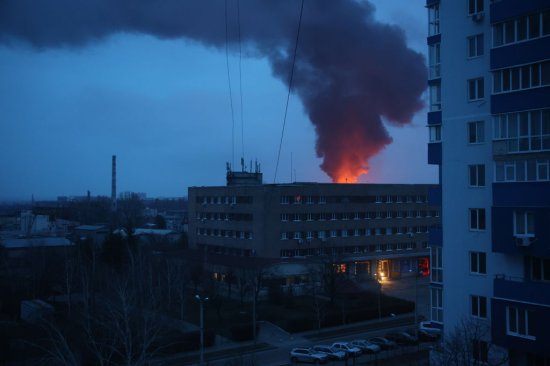
Here's why tit-for-tat attacks on Russian and Ukrainian energy infrastructure pose a bigger dilemma for Kyiv.
Just as the White House is reported to be lecturing Ukraine not to continue drone attacks on Russian oil refineries, Moscow unleashed an explosive onslaught against Ukrainian power and water plants from March 22 to 24 that has left an estimated 1.2 million Ukrainians in the dark and caused untold damage. Although both the 2020-2022 energy crisis and Russian atrocities in Ukraine have faded from many minds, the escalating attacks on civilian infrastructure on both sides have been affecting global markets and politics. They are also a stark reminder that a war in still Europe rages on.
[time-brightcove not-tgx=”true”]The latest Russian bombing round was devastating. At least 190 missiles and 140 shaheed drones struck across Ukraine in the last week, including at Kharkiv, Zaporizhzhia, Lviv, Sumy, and other cities. Five were killed and 31 injured in initial estimates. Precise numbers are classified, but Ukrainian Prime Minister Denys Shmyhal said that approximately 20 electricity stations and substations were hit, as well as underground gas storage facilities. Several power plants were destroyed. More than 20% of Ukraine’s power generation capacity was knocked out, according to Ukrhydroenergo CEO, Igor Syrota.
Beyond the human tragedy, the worst fallout is the destruction of the Dnipro Hydroelectric Dam, the largest in the country. Located just north of what used to be the Kakhovka Reservoir before Russia blew up the Kakhovka Dam in June 2023 and unleashed a massive humanitarian and ecological catastrophe, the smaller Dnipro Dam holds back a reservoir of 3.3 cubic kilometers of water. The dam appears to be holding but oil has leaked into the river. The attack also took out the power grid connection to the long-embattled Zaporizhzhia Nuclear Power Plant, Europe’s largest, raising the prospect of a blackout to the plant. Ukraine’s state-owned nuclear company Energoatom has said this presents an “extremely dangerous situation.”
These attacks are retaliation for Ukraine’s targeting of Russian oil refineries over the last few months in an effort to disrupt the Kremlin’s military supply lines, reduce its oil revenues, and sow unrest in advance of Vladimir Putin’s reelection campaign. Since January, Kyiv has sent dozens of drones deep into Russian territory, targeting at least 13 refineries. The strikes have taken out a major share of Russia’s refining capacity, albeit temporarily. A full 60%—18 refineries—could be at risk if Ukraine continues its strikes. And because much of the equipment used in the facilities is now sanctioned by the West and cannot be re-imported, replacements are difficult.
Oil prices have jumped a few percentage points after each Ukrainian drone attack on Russian refineries as markets jittered about global supply; they have risen about 15% in 2024 so far, to approximately $85 a barrel. Fears of higher prices, which could increase gasoline costs for U.S. drivers and thus inflation in the run-up to the November 2024 U.S. presidential election, seem to have prompted the White House this week to pressure Kyiv to stop targeting Russian refineries. The Biden Administration is reportedly also concerned that Russian retaliation could damage additional facilities, such as pipelines into Europe, and further elevate global energy prices. At least one Ukrainian official denied that the U.S. had urged Kyiv to stop the drone attacks. But Kyiv has nonetheless insisted that Russian refineries are “legitimate targets.”
The attacks on Russian refineries are particularly worrying for Western capitals because of their potential to roil energy markets. Russia is a major energy exporter, unlike Ukraine. The country is the second largest crude oil and natural gas producer globally. The world has paid Russia almost €640 billion ($694 billion) for energy commodities since its full-scale invasion of Ukraine—68% of which has been for oil, with 21% for natural gas and 11% for coal. U.S. and E.U. sanctions on Russian exports exclude key energy sector products—liquified natural gas (LNG), or uranium fuel for nuclear plants, or pipeline gas, for example—precisely because Western countries are not ready to pay the astronomical prices for energy that actually cutting off Russian fossil fuels would trigger.
And in a U.S. election year, the stakes couldn’t be higher. Higher prices at the pump, especially if attributable to Ukraine, will negatively impact President Biden’s chances of reelection. Kyiv says no European leaders have yet complained of energy market volatility, but whether or not that is true, the fact is that nervous oil markets make for nervous politicians. And with the storages that hold Europe’s desperately needed natural gas now being hit by Russian rockets in retaliation for Ukrainian refinery attacks, it is only a matter of time before E.U. leaders also become anxious.
Unfortunately, Ukraine is left in a lose-lose situation. While reports of White House pressure to stop targeting Russian refineries was met with fury in Ukraine and accusations of hypocrisy, Kyiv cannot get from the U.S. Congress the weapons and money it needs to survive due to American political dysfunction. As it pursues measures to turn the war again in its favor, these same actions risk alienating the White House. The future of Ukraine could rest in the balance of how President Zelensky chooses to manage these conflicting interests. It will be a fraught tightrope to walk.
TIME Ideas hosts the world's leading voices, providing commentary on events in news, society, and culture. We welcome outside contributions. Opinions expressed do not necessarily reflect the views of TIME editors.